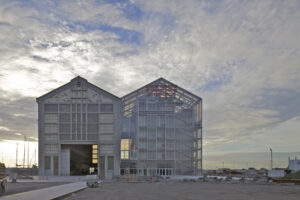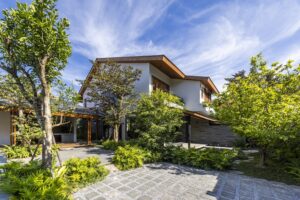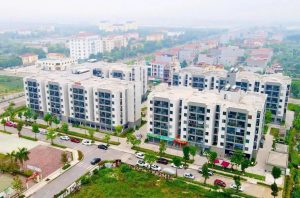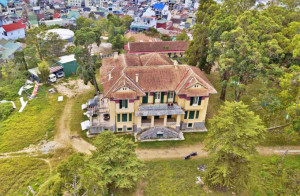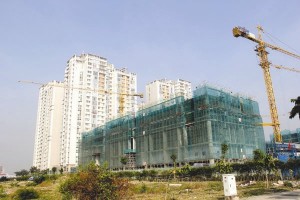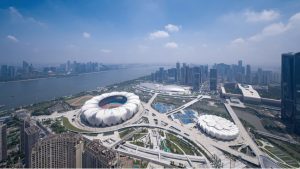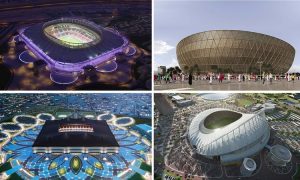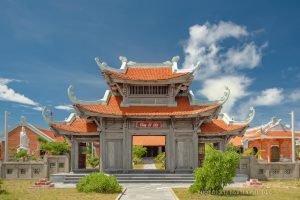Công bố quốc tế trong lĩnh vực kiến trúc, xây dựng (Tuần 3 tháng 6-2021)
Trong số này chúng tôi xin giới thiệu tới quý độc giả những nội dung chính của các công bố quốc tế đăng tải trên ScienceDirect và Springer Nature do Cục Thông tin khoa học và công nghệ quốc gia (NASATI) mua quyền truy cập như sau:
Quy hoạch đô thị:
– Định hướng lại các giải pháp thiên nhiên toàn diện hơn trong quy hoạch đô thị
– Đánh giá hành vi địa chấn của các công trình di sản bằng cách lập mô hình số
– Tìm hiểu môi trường sống của các nhóm sinh thái trong bối cảnh phân mảnh cảnh quan dựa trên lý thuyết mạng
– Hướng tới lồng ghép các dịch vụ hệ sinh thái đất vào quy hoạch không gian
– Các mô hình phát triển đô thị theo định hướng giao thông công cộng ở Trung Quốc
– Xem xét lại khả năng chống chịu rủi ro thiên tai ở các thành phố có mật độ dân số cao
Khoa học và công nghệ trong lĩnh vực xây dựng:
– Phân tích thử nghiệm sử dụng sợi quang polymethylmethacrylate trong bê tông phát sáng hiệu suất cao
– Đánh giá việc áp dụng các nguyên tắc kinh tế tuần hoàn trong cách tòa nhà
– Hiệu quả của chế độ bảo dưỡng bằng hơi nước đến các đặc tính của bê tông xanh cường độ cao siêu mịn chứa POFA
– Ứng dụng vật liệu nano trong kiến trúc
– Nghiên cứu ảnh hưởng của tối ưu hóa cơ cấu công nghiệp đến hiệu quả sử dụng đất đô thị ở Trung Quốc
Vật liệu xây dựng:
– Ảnh hưởng của kích thước sợi, khả năng hút ẩm theo chu kỳ và kháng nấm đến độ bền của vật liệu tổng hợp sợi tự nhiên
– Composite magie oxychloride đa chức năng với tính siêu kỵ nước ổn định, tự phát quang và tái sử dụng
– Đặc điểm hình thái cốt liệu thô và ảnh hưởng của nó đến các tính chất lưu biến và cơ học của bê tông tươi
– Nghiên cứu về đặc tính điện từ và hiệu suất khử vi sóng của bê tông biến tính sợi carbon
– Nghiên cứu tiềm năng sử dụng tro gỗ để thay thế một phần cho xi măng
Xin trân trọng giới thiệu!
QUY HOẠCH ĐÔ THỊ
1. Effects of sunshields on vehicular pollutant dispersion and indoor air quality: Comparison between isothermal and nonisothermal
Building and Environment, Volume 197, 15 June 2021, 107854
Abstract:
The effects of horizontal sunshields on the vehicular pollutant dispersion and indoor air quality of single-sided ventilation windward rooms along a street canyon is investigated in this study under both isothermal and nonisothermal conditions. A one-way coupling method is developed, i.e., an energy balance model is coupled to a CFD (computational fluid dynamics) simulation model. The simulation is performed for 3 p.m. on a hot summer day in Wuhan, China for cases under nonisothermal conditions. Three street canyon aspect ratios (AR: 0.5, 1, and 2) and two ambient wind velocities (0.5 m/s and 3 m/s) are investigated. The simulation results show that the use of sunshields on windward façades can prominently reduce the façade surface temperature by up to 5 K for each type of street canyon. Neglecting buoyancy effects generally results in an underestimate of the pollutant concentration and air exchange rate (ACH). Buoyancy increases the average ACH by 115.8%–1753.0% under weak ambient winds. Using sunshields under nonisothermal conditions increases the average ACH by approximately 20% for AR = 0.5 and 1 over not using sunshields. Sunshields are a widely used passive architectural design for thermal comfort that show promise for improving indoor air quality by increasing the air exchange rate under certain conditions and reducing pollutant concentrations around building openings. The study results also indicate that buoyancy cannot be neglected, especially in the presence of weak ambient winds.
2. Re-orienting nature-based solutions with more-than-human thinking
Cities, Volume 113, June 2021, 103155
Abstract:
Different ways of thinking and understanding urban problems and imagining solutions are needed to redress the suite of serious challenges facing cities. Focusing on urban nature, this conceptual paper begins from the standpoint that nature-based solutions (NBS) could help remake cities as places for more than just people; in other words, cities could encourage the flourishing of multiple species and ecosystems, including but not limited to, humans. Although cities were once considered ‘biodiversity wastelands’, they are now recognised as providing important habitat. However, NBS have been plagued by criticisms of anthropocentrism whereby human needs are prioritised over those of other species and ecosystems. To overcome this problem, the paper provides an outline of more-than-human thinking and suggests how relational concepts can help NBS move beyond an inherent anthropocentrism, and also begins to work through some of the complexities of making this shift. More-than-human thinking and theories have arisen in several disciplines, but despite a considerable presence in the literature, they have not yet been brought into conversation with NBS. The paper concludes that more-than-human thinking can generate deeper understanding of the interdependencies between all the entities that comprise cities, such that more inclusive NBS could be implemented.
3. Temporal and spatial heterogeneity research of urban anthropogenic heat emissions based on multi-source spatial big data fusion for Xi’an, China
Energy and Buildings, Volume 240, 1 June 2021, 110884
Abstract:
Anthropogenic heat emission (AHE) influences the local energy balance and intensify the urban heat island (UHI) effect. An accurate calculation of the AHE can improve the precision of UHI predictions. However, reliable AHE calculations with high temporal and spatial resolution in domestic research is still lacking. Therefore, this study proposes an approach to estimate the dynamic AHE by integrating multi-source Internet big data and high-precision urban spatial data. First, we quantified the dynamic distribution of residents’ trajectories by tracking multi-stage Internet geographic location data, real-time traffic conditions of Xi’an city, supplemented by on-site drone monitoring. Then the parameters of cooling and the thermal load coefficient of building emissions, personnel cooling loads, and traffic densities were introduced. Finally, the temporal and spatial dynamic rules of the AHE were revealed. Results showed the AHE was subject to a large changing amplitude. The diurnal AHE values of 64% of the blocks ranged from 93 to 498 W/m2, especially in some core commercial areas, the value could reach above 1000 W/m2 during the peak stages. Compared with previous research, this study dynamically evaluates the temporal and spatial heterogeneity of the AHE under different emission scenarios with a short update cycle and high spatial resolution.
4. Assessment of the seismic behaviour of heritage masonry buildings using numerical modelling: A study of Fernand Pouillon’s Totem Tower in Algiers, Algeria
Journal of Building Engineering, Volume 38, June 2021, 102183
Abstract:
This paper deals with the seismic response evaluation of the Totem tower of Diar Es Saada, which is one of the taller unreinforced masonry (URM) building in Algeria with twenty floors and 62 m in height. The tower located in Algiers, a town exposed to important earthquakes, has survived so far without major damage or alteration. This high-rise building was designed by the French architect Fernand Pouillon in 1953 without considering regulations for earthquake-resistant construction. It was built in only fifty days by adopting an original structural system and an innovative construction processes developed by this architect: URM stone and brick load-bearing walls with reinforced concrete floors. The study carried out consists of a multidisciplinary approach. First, a detailed diagnosis was performed on site to assess the state of conservation of the building. Then, the seismic behaviour was modelled and analyzed by using both linear dynamic and non-linear static analysis in SAP2000 and TreMuri software. With regard to the current Algerian seismic design regulation, the results obtained in terms of time period, frequency, storey drifts and displacements showed that the tower can be considered as an earthquake-resistant building fulfilling the required structural safety conditions. In this respect, the Totem tower of Diar Es Saada deserves to be classified as a national heritage and its satisfactory overall structural behaviour confirms that the architect Pouillon has also excellent skills in engineering construction.
5. Understanding ecological groups under landscape fragmentation based on network theory
Landscape and Urban Planning, Volume 210, June 2021, 104066
Abstract:
In the context of landscape fragmentation, a variety of ecological conservation theories have been proposed to maintain habitat connectivity. These theories focus on the connectivity of the ecological corridors in ecological space but ignore the community structure of ecological space. However, community structure is ubiquitous in ecological space. Our study predicted habitat quality of ecological patches by using an artificial neural network and species occurrence points. Then, the ecological space network (ESN) was proposed and constructed by taking large ecological patches and fragmented patches as habitat nodes. Based on island biogeography theory (TTIB) and network community detection, the ecological groups in the ESN were proposed and identified. They are considered to be collections of ecological land with close species connections. After that, the hierarchy of the ecological group was analyzed, and the existing policy was evaluated. The results show that there were 39 ecological groups in the ESN. The dendrogram of the hierarchy shows that all ecological groups can form five bigger ecological groups. The extent of the bigger groups proves that the ecological groups in the eastern part are closely connected. By analyzing the protection of ecological control lines on the linkages among ecological groups, we found that the existing policy could protect most of the ecological groups separately, but could not maintain connectivity among ecological groups, leading to habitat isolation. We believe that the concept of “ecological group” makes up for the lack of “habitat isolation” in the existing theory. The idea can understand the hierarchical structure of ecological space, which is conducive to the maintenance of ecological integrity.
6. Bypassing institutional barriers: New types of transit-oriented development in China
Cities, Volume 113, June 2021, 103177
Abstract:
China is often viewed as an emerging experimental base for transit-oriented development (TOD) practices because of its rapid urban growth and development of mass transit networks. The implementation of TOD can be heavily influenced by institutional barriers to urban growth. However, some newly emerging types of TOD practice allow planners and decision-makers to bypass some of the institutional barriers and achieve a certain degree of integrated development. Current academic literature, however, has little to say on how these informal institutional solutions go around these barriers. This article aims to fill this gap by examining three different types of TOD practice as applied in Guangzhou and Shenzhen. We analysed and compared the origins and effects of abovementioned informal institutional arrangements under entrepreneurial governance. We found that land value capturing can replace the existing governance mode in which local government heavily relies on revenue from land-leasing and realise better integration of transit and land development. We conclude with several suggestions for institutional reform based on these new types of TOD experiments.
7. A holistic approach to the evaluation of the indoor temperature based on thermal comfort and learning performance
Building and Environment, Volume 196, June 2021, 107803
Abstract:
Indicators and methods in current thermal comfort evaluation models are based on the average level for entirely society, which is difficult to use to a direct guide for the design of classroom thermal environments in primary and secondary schools. The determination of indoor parameters is mainly based on a single thermal comfort index, with little consideration of the impact of thermal environment on learning performance, and combinations of both considerations is even rarer. The quantitative relationship between temperature and thermal comfort was established, with percentage of satisfied as a thermal comfort evaluation index. The quantitative relationships among percentage of qualified, performance index, and temperature were established with the group’s percentage of qualified was proposed to characterize learning performance. Therefore, a method for determining the temperature design parameters of the classroom was proposed, taking into consideration the comprehensive effects of thermal comfort and learning performance. Temperature ranges of different thermal comfort and learning performance levels were recommended. The upper limit of the recommended temperature with higher comfort and learning performance was 5 °C lower than the low limits of international standards, which could effectively reduce energy consumption of school buildings in winter, and provide a theoretical basis for improvement of classroom environment design.
8. Towards embedding soil ecosystem services in spatial planning
Cities, Volume 113, June 2021, 103150
Abstract:
This paper aims to contribute to the limited understanding and recognition of soil ecosystem services (SoES) in spatial planning. In light of its critical role in climate crises and due to its global degradation, soil has drawn considerable attention in the recent global agenda. As one of its vital services, soil serves as a terrestrial carbon pool, which significantly contributes to offset greenhouse gas emissions in the atmosphere (EEA, 2012). The capacity of soil in climate change mitigation and in the provision of ecosystem services can be enhanced and safeguarded by integrated spatial planning strategies. However, due to limited political attention and fragmented frameworks on land and soil management, anthropogenic pressures on soil are reaching critical limits and causing soil degradation. In this context, the paper underlines the interconnectedness of SoES, climate change and spatial planning and discusses their multifaceted interactions through a hypothetical framework based on the Nexus approach. Herein, the paper aims to (i) develop an outline for classification of SoES; (ii) analyze background dynamics of soil degradation interacting with climate change; (iii) discuss recent policy frameworks referring to soil protection and SoES; (iv) propose measures for possible integration of SoES into spatial planning through SoES-Climate Change-Spatial Planning Nexus.
9. An integrated approach towards spatial identification of restored and conserved priority areas of ecological network for implementation planning in metropolitan region
Sustainable Cities and Society, Volume 69, June 2021, 102865
Abstract:
Rapid urbanization has led to landscape fragmentation, habitat loss, and the disruption of ecosystem functions. Ecological networks (ENs) are effective comprehensive spatial regulation schemes for mitigating the negative impacts of rapid urbanization on ecosystems. However, the methods of constructing ENs were not sufficiently developed for determining its spatial range and overlooked its internal defects and external threats which may affect its function and effectiveness. Taking the Shanghai metropolitan region as a case study area, this study developed an integrated approach to identify the spatial range, internal defects and external threats of ENs based on circuit theory and assessment of ecological degradation risk to identify the restored and conserved priority areas of ENs. The results show that the restored priority areas included the obstacles and ecological fracture points of ecological corridors in the terrestrial ecosystem (TEC), covering an area of 79.21 km2, and the conserved priority areas were composed of 273.3 km2 of areal ecological patches in the TEC, and 891.35 km of waterways of ecological corridors in the aquatic ecosystem (AEC). This approach attempts to provide a spatial reference for the identification and implementation of ENs in metropolitan regions by focusing on restored and conserved priority areas.
10. Thermal and humid environment improvement of the protective clothing for medical use with a portable cooling device: Analysis of air supply parameters
Energy and Buildings, Volume 240, 1 June 2021, 110909
Abstract:
COVID-19 has caused a huge impact on people’s daily life and has made great damage on national economy. All the epidemic situation not only require the improvement of medical science, but also the corresponding auxiliary research field, e.g. the improve of protective clothing for medical use (MUPC). Developing a new kind of MUPC with portable cooling devices to improve medical workers’ thermal comfort and protection performance of MUPC is imminent. In this paper, an integrated MUPC with a portable vortex tube cooling device was studied with experimental method. In a phytotron, a manikin wearing the MUPC was experimentally studied in terms of the influence of environment temperature and cool air supply conditions. On the basis of experiments, the MUPC inside air temperature and relative humidity, skin temperature of human body was studied with simulation method. Overall thermal sensation vote (TSV) and local TSV of human body were calculated, based on simulation results, to evaluate human thermal sensation. The results showed that, first, 50 L/min cool air flowrate with 18–20 °C supply temperature can create a good MUPC inside thermal sensation environment, for both head supply and body supply conditions. Both body supply condition and head supply condition cannot create a uniform MUPC inside thermal sensation environment. Second, MUPC inside air relative humidity is around or lower than 60% for most body parts, except for air supply position and body parts that air is difficult to reach. Thirdly, with cool air supplied into MUPC, a micro-positive pressure environment can be obtained, and the protection performance of MUPC can be improved.
11. Understanding urban centers in Shanghai with big data: Local and non-local function perspectives
Cities, Volume 113, June 2021, 103156
Abstract:
Along with the rising space-of-flow, non-local functions are identified as a comparable force to local urban-hinterland relations that determine urban development. However, little evidence and explanation have been presented for how urban centers (UCs) are made of local and non-local functions. By examining the case of Shanghai, this paper endeavors to fill the gap with multiple big/open datasets. We first identify UCs using a new method as well as employment/activity densities inferred from cell phone data. Then, local and non-local forces are measured using functional and interaction metrics derived from theoretical deduction based on classic economic-space theories. Our result demonstrates that non-local functions have become a comparable force as local functions. Spatial analyses show that non-local functions generally agglomerate in about 30 UCs (27%) in the inner-ring Puxi area, presumably indicating a locational preference for local services and demand; local functions are distributed more like the central places diagram in Isard (1956). Additionally, specialization analysis of UCs shows clear evidence that non-local functions cause both centralization and decentralization in UCs, which can be well explained by the deductive theoretical patterns. This paper contributes to the literature of urban spatial structure with new evidence as well as a generic theoretical explanation and transferable methodologies.
12. Landscape ecological enhancement and environmental inequalities in peri-urban areas, using flora as a socio-ecological indicator – The case of the greater Paris area
Landscape and Urban Planning, Volume 210, June 2021, 104062
Abstract:
The peri-urban areas of European metropolises offer a diversity of vegetated spaces – forests, agricultural land, abandoned or preserved natural areas – that receive ecological attention from city dwellers. This attention varies locally depending on the socio-economic characteristics of the population and raises the question of ecological inequalities in accessing different types of landscapes. Once the target of a green belt project that was never carried out, the peri-urban areas of the Paris region have undergone different trajectories according to local biophysical, social and political characteristics. This article shows how these characteristics interconnect and explain the ecological enhancement or abandonment of landscapes in a complex urban region using flora as an indicator. To do so, (1) we build a landscape analysis at different scales, (2) we collect botanical data at 252 sites and analyse it through statistical multivariate analysis, and (3) we correlate the plant communities’ spatial distribution to socio-economic contexts and planning projects. The results show that the socio-political dimension is decisive for understanding how and why vegetated areas are enhanced or abandoned and helps to correlate ecological preservation and socio-economic contexts locally. Flora reflects these dynamics: the type of management of forest or arable lands, as well as a mixed deprivation/luxury effect on flora. Peri-urban vegetated landscapes are a target for local political projects that may lessen environmental inequalities, or conversely and more insidiously, may perpetuate them.
13. Key drivers of avifauna in greenspace of institutional campuses in a state in Western Africa
Urban Forestry & Urban Greening, Volume 61, June 2021, 127092
Abstract:
Urbanization is causing rapid loss of important habitats for wildlife and most birds in urban areas are therefore unable to maintain a viable population due to poor habitat. However, some birds are able to retreat to urban greenspaces for safety and survival such that these areas may sometimes support high biodiversity. Understanding the dynamics that shape the distribution of birds in urban greenspaces is therefore necessary for setting priorities to improve outcomes for biodiversity conservation. In this study, we investigated the key drivers of bird species richness and abundance in greenspaces of institutional campuses. We surveyed a total of 53 transects (each of 500-meters in length and 200 m wide) for bird species in 15 institutional campuses in Plateau State, North-Central Nigeria. We sampled habitat level variables at every 100 m section of the transect, and also obtained landscape-level variables such as campus size and Normalized Difference Vegetation Index (NDVI) from satellite imagery. Data analysis revealed that bird species richness and abundance differed significantly between campus categories (highly, moderately and sparsely woody). We identified campus age, number of tree species and number of shrubs as strong and positive predictors of avifauna. Pedestrian and vehicular traffic however, were negatively related to bird species richness and abundance. We recommend that conservation effort and management planning should focus on the planting and growth of multiple components of vegetation structure with diverse trees and shrub complexity.
14. Simplified evaluation metrics for generative energy-driven urban design: A morphological study of residential blocks in Tel Aviv
Energy and Buildings, Volume 240, 1 June 2021, 110916
Abstract:
For almost two decades, the Zero Energy Buildings (ZEB) standard has epitomized a commitment to the high energy performance of buildings. Nevertheless, the applicability of ZEB in hot climates is currently limited and furthermore, in light of the current limitations of traditional building energy modeling methods, new methods are necessary to effectively evaluate the energy balance potential of larger districts. To help bridge this gap, this paper introduces solar-based (both sun-hours and solar irradiation) and geometry-based prediction metrics to be used in optimization studies to evaluate the impact of urban morphology on the energy balance of residential blocks in hot urban contexts. These prediction metrics are derived from the simulated energy performance of 1,944 parametric variations of residential blocks in Tel Aviv. In a regression analysis, these metrics recorded high correlation with energy demand, energy supply and the balance between them. To test the applicability of these metrics for optimization, the RBFMOpt method is employed in a multi-objective optimization study of the energy supply and demand of a nine-block residential district in Tel Aviv. Detailed energy simulations are performed for the best non-dominated results from the solar and geometric optimization studies and compared to the non-dominated results from a full energy optimization run. The results indicate that these metrics – the solar and geometric area-weighted exposure and shading indices – can serve as effective energy performance indicators to inform early-stage morphological decisions making. This workflow promotes urban energy optimization towards more harmonized energy supply and demand driven approaches.
15. The role of the vegetation structure, primary productivity and senescence derived from airborne LiDAR and hyperspectral data for birds diversity and rarity on a restored site
Landscape and Urban Planning, Volume 210, June 2021, 104064
Abstract:
Management of restored areas requires ecologically meaningful spatial data providing objective measures of restoration success. Understanding relationships between species diversity on the one hand and habitat heterogeneity and productivity on the other can help establish such measures and prioritize restoration management. We used airborne LiDAR and hyperspectral data to derive characteristics of vegetation structure, primary productivity and senescent vegetation (i.e. old dead vegetation) for prediction of richness and rarity of bird communities colonizing newly available habitats restored after coal mining. In addition, we analysed, which type of restoration (i.e. agricultural, forest, or spontaneous succession) results in more favourable conditions. The boosted regression trees explained 52% and 12% of deviance of overall species richness and rarity, respectively. We found that the overall species richness was strongly affected by the variance in vegetation structure, while the rarity was also affected by the presence of senescent vegetation. The relative importance of variables differed between the richness and rarity. The shrub cover had a strong positive effect on both, while the tree cover had a strong positive effect on species richness. The herbaceous cover and presence of senescent vegetation had positive effects on species rarity. This study, therefore, supports the necessity to create a mosaic of habitats with heterogeneous vertical structure including all layers of vegetation and highlights the importance of senescent vegetation. Combination of forests restoration with sites left to spontaneous succession appears to be the best strategy to increase both bird species richness and rarity in newly restored sites after coal mining.
16. Rethinking disaster resilience in high-density cities: Towards an urban resilience knowledge system
Sustainable Cities and Society, Volume 69, June 2021, 102850
Abstract:
Fostering high-resolution disaster resilience assessment is essential for high-density cities (HDCs) given their congested built environment. This study introduces and demonstrates a spatial disaster resilience profiling (S-DReP) framework for HDCs. First, an indicator set is presented for resilience assessment in HDCs within a built environment. Second, this indicator set is adopted to identify the spatially-varying patterns of neighbourhood disaster resilience in HDCs. In contrast to typical resilience frameworks, the developed framework also takes into account the spatio-environmental factors within the built environment. As an illustrative example, we demonstrate the application of S-DReP framework to one of the most populated districts in Hong Kong, namely Sha Tin. Building-level data for 24 indicators and infrastructure data are used to compute a spatially-relative disaster resilience index. To inform the planners with disparities among different resilience components, the Analysis of Variance approach is employed to explore the distribution of resilience. To identify the priority intervention areas, the spatial assessments are made using several geo-information models. The proposed S-DReP framework provides a roadmap to establish an urban resilience knowledge system in HDCs enabling practitioners, decision-makers, and local bodies to design action plans for future vigilance reducing the worsening impacts of hazards on cities.
17. Optimizing the beam and sky diffuse radiation calculations under random obstructions of urban environments
Building and Environment, Volume 196, June 2021, 107806
Abstract:
Solar radiation is important in studies of the energy and environment of buildings. Calculations of the direct beam and sky diffuse radiation, however, usually rely on numerical approaches, which can lead to notable calculation burdens. This research evaluates the update interval of the daily solar position series and the skydome discretization densities as they affect the estimation accuracies of the direct beam and sky diffuse radiation, respectively. Additionally, an approach is proposed for studying the direct beam radiation using a number of representative sun directions, the density of which is optimized for efficient radiation studies under external obstructions. Field measurements and simulations show that 61 sky elements can be sufficient for diffuse radiation estimations in low-latitude regions. For the direct beam, on the other hand, more than 1100 representative sun directions are necessary. The accuracy is comparable to that of the approach in which the sun position is updated in the calculation interval every 2–10 days. The representative sun direction approach and the results of the optimized day interval and sky discretization density are essential to efficient building simulations conducted at high frequencies.
18. Usage of urban green space and related feelings of deprivation during the COVID-19 lockdown: Lessons learned from an Italian case study
Land Use Policy, Volume 105, June 2021, 105437
Abstract:
This study investigated perceptions and behavioral patterns related to urban green space (UGS) in Italian cities, during the period of national lockdown imposed due to the outbreak of SARS-CoV-2 in the spring of 2020. A survey was used to examine the responses of population groups in different municipal areas, comparing those in government-defined “red zones”, mostly in the northern regions of the country, with “non-red zones” in the rest of the country, where the rate of infection was much lower. A total of 2100 respondents participated in the survey. The majority of respondents declared themselves to be habitual users of UGS, especially of parks or green areas outside the town – mainly visiting for relaxation and physical exercise, but also for observing nature. In the northern regions people more commonly reported the adoption of sustainable practices, in terms of the utilization of tools for “green mobility”. During the lockdown, habits changed significantly: only one third of respondents reported visiting UGS, with frequent visits made mainly for the purpose of walking the dog. Other motivations included the need for relaxing, mostly in the red zones, and for physical exercise in non-red zones. The reduction in travel to urban parks was accompanied by increased visitation of gardens and other green spaces in close proximity, as social distancing and other regulations imposed restrictions on movement. In all regions, respondents who could not physically access UGS expressed a feeling of deprivation which was exacerbated by living in towns located in red zones, being a usual visitor of UGS and having no green view from the window. The extent to which these visitors missed UGS depended on the frequency of visitation before the pandemic and the UGS distance, as well as the type of previous activity. In fact, those activities that were most common before the pandemic were missed the most, reinforcing the importance of green areas for social gathering, sports, and observing nature – but simply “spending time outdoors” was also mentioned, even by those who visited UGS during the lockdown, as the time outdoors was not enough or not fully enjoyed. The feeling of missing UGS was only partially alleviated by the green view from the window – only a more open view to a natural landscape or adaptation to a view with little greenery reduced such feeling.
19. Urban growth management and territorial governance approaches: A master plans conformance analysis
Land Use Policy, Volume 105, June 2021, 105436
Abstract:
Urban sprawl is related, among other factors, to local planning policies that aim to drive economic growth through spatial planning but fail to regulate urban expansion. Even land use plans originally designed to restrict urban sprawl appear to be ineffective when approached by local authorities. Withal, little attention has been given into analysing local master plans implementations and their relation with territorial governance. In this paper, we focus on the role of territorial governance arrangements in master plans implementation practices. Also, we explore the spatial outcomes of urban growth in a medium-sized Brazilian city, conformance wise to its Master Plans, under different administrations from contrasting political parties. The purpose is to identify discrepancies in urban growth spatial outcomes, according to territorial governance, quantitatively assessing whether the observed growth complied with zoning strategies or comprised nonconforming development. It is arguable that governance capacity affects the spatial distribution of urban growth and, consequently, the regulation of urban sprawl. The results show disparate patterns of urban growth corresponding to different administrations, even under the same plan implementation, suggesting that the spatial outcomes could have been shaped either by the enforcement or the abstention of planning regulations, characterizing contrasting approaches on territorial governance.
20. Between the state and citizens: Changing governance of intermediary organisations for inclusive and sustainable urban regeneration in Seoul
Land Use Policy, Volume 105, June 2021, 105433
Abstract:
Cities across East Asia once experienced rapid economic growth and urban development under a strong interventionist state. The recent economic slowdown and political changes have pressured them to find alternatives to the previous state-led or market-driven urban development. New forms of participatory governance have been devised to mobilise citizen participation in decision-making. Citizen participation, however, is not simply about direct interactions between the state and citizens. It is also guided and facilitated by intermediary organisations that are state- or self-funded bodies working between the state and citizens. Seoul in South Korea is a case in point. Over the past decade, Seoul Metropolitan Government has institutionalised intermediary organisations to expand citizen participation in diverse areas of urban life. In urban development, a more inclusive approach has been put forward through new partnerships between government, intermediary organisations, and citizens. In this article, a case study of such partnership is critically examined. Urban regeneration in the Changsin-Sungin Area shows two meaningful changes in the governance of the intermediary organisation. The first change occurred when the intermediary organisation recruited residents as staff members and helped them to create a new local cooperative. The second change happened when the local cooperative took over the role of the intermediary organisation. Analysis of these changes revealed that intermediaries have a contradictory role in urban regeneration. On the one hand, the intermediary intervention has expanded citizen participation and improved consistently the engagement of the community of practice. On the other hand, intermediary intervention has served to instrumentalise citizen participation and constrain the growth of an autonomous community of practice while helping the state to retain control over urban regeneration. In this sense, the intermediary-led participation contains seeds of yet-to-be realised potential, albeit with the current flaws, for more inclusive and sustainable urban regeneration, which this study recognises as an integral part of emerging post-developmental urbanisation in South Korea.
KHOA HỌC VÀ CÔNG NGHỆ TRONG LĨNH VỰC XÂY DỰNG
1. The high-performance light transmitting concrete and experimental analysis of using polymethylmethacrylate optical fibers in it
Journal of Building Engineering, Volume 38, June 2021, 102076
Abstract:
The purpose of the current study is to investigate the optical and physical properties of high-performance light transmitting concrete which was prepared by Portland cement, polymethylmethacrylate (PMMA) optical fibers, silica fume, fine aggregate, polycarboxylate superplasticizer, silica powder, and water in a given proportion. Many samples of light transmitting concrete with 3, 5, 7, 10, & 15% volumetric PMMA optical fibers in it were produced. The laboratory tests were determined in order to specify the optimum fraction of optical fibers in samples in terms of performance, and evaluation of light transmitting properties of concrete based on single high-performance concrete mixing design depending on optical fibers quantity. As the findings revealed, the compressive strength decreased with an increasing volume fraction of optical fiber in the light transmitting concrete samples. Light transmitting performance of specimens was tested by the designed lightbox and optical power method (spectrometer test). Optical power increased nonlinearly with an increasing number of optical fibers; however, it does not transmit infrared waves as well as visible waves. Considering the light transmittance of light transmitting concrete samples, compressive strength, and the amount of used optical fibers in them, the light transmitting concrete sample that contains 10% of the volumetric optical fibers in it, can be optimum in terms of cost and performance.
2. Printability and efflorescence control of admixtures modified 3D printed white Portland cement-based materials based on the response surface methodology
Journal of Building Engineering, Volume 38, June 2021, 102208
Abstract:
3D printed white Portland cement-based materials (WPCMs) were supposed to be a promising cementitious material used in the 3D printing of colored and decorated building components due to the excellent whiteness. This paper was concentrated on the rheology, printed structure, and efflorescence control of 3D printed WPCMs modified by the hydroxypropyl methylcellulose (HPMC), calcium formate (CF), and ethylene-vinyl acetate (EVA) powder based on the extrusion-based 3D printing system. The experimental results show that the HPMC and EVA improve the static yield stress of 3D printed WPCMs significantly, however, the reverse phenomenon is true for the CF dosage of 0–1%. When the dosage of CF exceeds 1%, the yield stress increases gradually. Additionally, the printed structure is well built up when the dosages of HPMC is larger than 0.3%. Furthermore, the response surface methodology (RSM) is used to investigate the properties of 3D printed WPCMs with hybrid admixtures due to their different functions. The optimal dosage of hybrid admixtures is determined for realizing controllable rheology and stable printed structure.
3. Quasi-static testing of concrete masonry shear walls with different horizontal reinforcement schemes
Journal of Building Engineering, Volume 38, June 2021, 102201
Abstract:
Constructions built with partially grouted reinforced masonry (PG-RM) shear walls are common in several countries, and consequently, different construction solutions can be expected. In this context, one of the main differences detected is the type of horizontal steel reinforcement used. The most traditional options consist of bed-joint reinforcement and bond-beam reinforcement. Despite the advances in this research area, there is little experimental evidence to determine which of these horizontal reinforcement schemes exhibits a superior performance under seismic loads. Thus, the research described in this paper focused on assessing and comparing the seismic performance of PG-RM shear walls with different horizontal reinforcement options. For this purpose, four concrete masonry walls with an aspect ratio of 0.86 were tested undergoing constant axial pre-compression and quasi-static cyclic incremental lateral displacements. The tested walls had the same horizontal reinforcement ratio but different layouts (only bed joint reinforcement, only bond beam reinforcement, and a combination of them). The other design characteristics remained constant. The obtained results were analyzed in terms of the force-displacement curves and seismic performance parameters such as the maximum resistance, stiffness decay, energy dissipation, and equivalent viscous damping ratio. In addition, a comparative analysis of damage progression of the tested walls was carried out using the digital image correlation (DIC) technique.
The tested walls experienced progressive deterioration of the lateral stiffness in proportion to drift increments regardless of the reinforcement scheme. Once achieved the lateral resistance, the degradation of the behavior accelerated, turning into a rather unpredictable response. Employing different horizontal reinforcement layout showed no influence on the lateral capacity of the walls when the same horizontal reinforcement ratio and material qualities are used. It was also observed that the distributed bed-joint reinforcement was better than the bond-beam reinforcement layout in controlling crack widths. Additionally, a combination of bond-beams and bed-joint reinforcement seems to be the most suitable reinforcement strategy based on hysteretic behavior, energy dissipation capacity, and ductility. The presented experimental evidence is promising, although further studies are required in order to promote its use in design codes and construction projects.
4. Application of circular economy principles in buildings: A systematic review
Journal of Building Engineering, Volume 38, June 2021, 102041
Abstract:
The transition from linear economy into circular economy is not realizable until circular economy principles are applied into the life-cycle stages of buildings which is a proactive design approach to manage buildings from cradle to cradle. Resources are depleted without any effective programme for material recovering. Hence, this study was aimed at identifying suggested advancements for the application of circular economy principles in buildings. The study objectives were to systematically review/analyse proposed circular economy interventions in buildings and finally conclude on findings whilst identifying research gaps. Therefore, the study gathered related articles for review under seven identified major circular economy strategies. Results revealed that there was a progressive awareness/research on circularity in buildings although its awareness/acceptance were still at their infancy. Sixty-four articles were analysed under identified strategies, leading to discussion of major interventions. The review revealed practical approaches to the application of circular economy in buildings, also identifying aspects that received little attention, including research-gaps. It was recommended that future research should focus on obscured areas identified for a holistic approach. Conclusions were deducted from the analysis and recommendations made based on researchers work on the susceptibility of buildings to resource efficiency in a circular economy.
5. Application of microwave waveguide techniques for investigating the effect of concrete dielectric and reflection properties during curing
Journal of Building Engineering, Volume 38, June 2021, 102209
Abstract:
This study deals with the measurement of dielectric constant, the magnitude of reflection coefficient, and compressive strength for G30, G40, G50, and G60 concrete mix after 0, 3, 7, 14, 21, and 28 days curing. The open-ended coaxial probe of 4.8 cm, WR510, and WR340 waveguide models operating over a frequency range of 85 MHz to 1.8 GHz, 1.45–2.2 GHz, and 2.17–3.3 GHz, respectively, are applied. Fifteen concrete cube samples 150 × 150 × 150 mm size were casted for each mix. The experimental result shows that the dielectric constant and magnitude of the reflection coefficient decrease gradually until 21 days, then increase at 28 days age of concrete. Correlated the concrete dielectric constant with design compressive strength. The results corroborate that microwave techniques correlate well for evaluating the strength of concrete. The strength characterization is suitable with related material composition, necessary experimental setup, and environmental conditions applied in this study. Furthermore, curing conditions, effects must be accounted; it is valuable in establishing a correlation between conventional properties and microwave properties of concrete.
6. The effect of different exposure conditions on the pull-off strength of various epoxy resins
Journal of Building Engineering, Volume 38, June 2021, 102223
Abstract:
This study aims to investigate the interfacial bond between epoxy resin coatings and concrete substrates exposed to different exposure conditions. As test variables, five different epoxy resins, three exposure conditions, and four exposure times were selected and investigated. The exposure conditions significantly affected the pull-off strength. As the exposure times increased, the pull-off strength decreased, except for bisphenol A with cresyl glycidyl ether (BGEI). BGEI showed the highest pull-off strength during exposure to tap water (3.78 MPa) and seawater (3.66 MPa). However, adding phenolic novolac resin and hexanediol diglycidyl ether, which were reactive diluents, reduced the pull-off strength during tap water exposure compared to that observed during seawater exposure, owing to the penetration of tap water. Therefore, the pull-off strength in the exposure environment must be considered before using reactive diluents and fillers in epoxy coatings.
7. Effect of nanosilica/metakaolin ratio on the calcium alumina silicate hydrate (C-A-S-H) formed in ternary cement pastes
Journal of Building Engineering, Volume 38, June 2021, 102226
Abstract:
Supplementary Cementitious Materials (SCM) such as Metakaolin and Nanosilica can be used in blended Portland cements to improve performance of the cement matrix. The use of these materials can also change hydrate formation, altering properties of Calcium Silicate Hydrate (C–S–H) such as chemical composition and molecular structure. The objective of this research was to study the combined effect of these SCM’s in different metakaolin/nanosilica ratios forming ternary mixtures with OPC, evaluating properties of both C–S–H and overall paste. Results showed these mixtures had the highest strength values and lowest portlandite content at 28 days. Furthermore, their C-A-S-H was formed in higher content, had higher aluminum inclusion and longer molecular chains. Analyzing the results, a synergistic effect between nanosilica and metakaolin, dependent on their ratio in paste composition, was observed.
8. Properties of concretes bearing mixed recycled aggregate with polymer-modified surfaces
Journal of Building Engineering, Volume 38, June 2021, 102211
Abstract:
The growing socio-economic interest in conserving the environment constitutes a challenge for businesses with a heavy environmental impact. In the construction industry, the efficient use of recycled construction and demolition waste (CDW) as aggregates in structural concrete and the implications of that practice for a sustainable flow of materials are contributing to the establishment of a circular economy. Mixed recycled aggregates (MRA) account for a substantial fraction of the total. The main hurdle to MRA valorisation is its non-uniformity and certain intrinsic properties that have a direct effect on the performance of recycled concretes. In light of those drawbacks, this study assessed a surface treatment consisting in soaking these mixed materials in polymers to improve their physical and mechanical properties with a view to their use, determining the optimal treatment conditions (concentration, soaking time and drying method). The study also addressed the effect of using the treated MRA to replace 100% of the natural gravel (~40% of the total aggregate) on the fresh state consistency and hardened state compressive and tensile strength and water permeability of the new material. The findings showed that the treatment induced a reduction in mixed recycled aggregate water absorption and a rise in its abrasion resistance. Although treating the MRA as described had no significant effect on concrete mechanical properties, it improved durability significantly.
9. A machine-learning-based method for thermal design optimization of residential buildings in highly urbanized areas of Turkey
Journal of Building Engineering, Volume 38, June 2021, 102225
Abstract:
In 2008, the Turkish government legislated a new regulation mandating the retrofit of existing buildings and construction of energy-efficient buildings. Owing to the requirements of the legislated regulations and environmental concerns, constructing energy-efficient buildings has become a necessity. Researchers working in this field have proposed various optimization techniques to determine energy-optimal design solutions. However, the proposed techniques require a large number of simulations thereby reducing the practicality and inhibiting the wider diffusion of the technique into the industry. Recent studies have demonstrated that the use of surrogate models as alternatives to commercial energy simulation tools significantly reduces the time required for optimization, and a large number of buildings can be optimized in a shorter period. In this study, we aimed at developing a surrogate model-based integrated optimization system to obtain energy-optimal thermal designs for residential buildings in the most urbanized cities in Turkey under different levels of budget constraints. For this purpose, an integrated system consisting of a genetic algorithm optimization technique and gradient boosting machine based surrogate model was developed. The results indicate that the proposed surrogate model-based optimization system is an effective method of overcoming the difficulties of simulation-based optimization methods and it can be integrated into the daily workflow of designers. This study reveals the performance of the scarcely used gradient boosting machine based surrogate model in predicting the thermal loads of buildings. The outcomes of this research will guide designers in finding energy-optimal design alternatives for residential buildings.
10. Influence of steam curing regimes on the properties of ultrafine POFA-based high-strength green concrete
Journal of Building Engineering, Volume 38, June 2021, 102204
Abstract:
This paper investigated the influence of steam curing regimes on the properties of high-strength green concrete (HSGC) containing varying quantities of ultra-fine palm oil fuel ash (U-POFA) from 0%, 20%, 40% and 60% from the mass of Portland cement. The HSGC specimens were steam cured at 50 °C, 65 °C, and 80 °C for 16 h in order to evaluate the effect of curing temperatures. Besides, the HSGC specimens were also cured at 80 °C for 6, 11 and 16 h in order to investigate the effect of curing period. The influence of different temperatures and periods of steam curing on the development of the compressive strength (CS) and microstructure of the HSGC was investigated at 1, 3, 7, 28, 90, 180 and 360 days. The results showed that replacing 20%, 40% and 60% of ordinary Portland cement (OPC) with U-POFA exhibited a decrease in the CS in early ages up to 7 days, whereas the long-term CS at 360 days improved by 5.4%, 10% and 9.2%, respectively in comparison to the control concrete mixture. It was also found that the application of steam curing regime at 80 °C for 16 h contributed towards increasing the strength of concrete by 193% at 1 day for HSGC containing 60% U-POFA when compared to normally cured specimen. The trends in CS development were complimented with microstructural analyses based on TGA, XRD and SEM/EDX. It was observed that steam curing has a significant influence on microstructures of matrix in early ages. However, it can be concluded that the partial replacement of U-POFA has positive impacts on the long-term properties of the HSGC at 360 days.
11. Influence of carbonation curing on hydration and microstructure of magnesium potassium phosphate cement concrete
Journal of Building Engineering, Volume 38, June 2021, 102203
Abstract:
Magnesium phosphate cements are normally referred as chemically bonded ceramic materials and have a vast range of potential applications, due to their excellent performance. This study aims to investigate the effects of carbonation curing on hydration and microstructure of magnesium potassium phosphate (MKPC) concrete. Concrete specimens were prepared and cured in ambient as well as carbonation curing environment. The performance of MKPC concrete specimens were examined via compressive strength and nano indentation tests. In addition, microstructure, and hydration products of MKPC specimens on carbonation curing were investigated via Backscatter electron microscopy (BSEM), Energy dispersive X-ray spectroscopy (EDS), X-ray diffraction (XRD), Fourier transform infrared spectroscopy (FT-IR), and Thermogravimetric analysis (TGA). Experimental results show that the MKPC concrete with carbonation curing represents increased mechanical properties compared to uncarbonated MKPC concrete specimens. The results also showed that the production of magnesium carbonate like Nesquehonite under carbonation had a filling effect that refined the microstructure and enhanced the mechanical properties of the composites.
12. Study the effect of industrial structure optimization on urban land-use efficiency in China
Land Use Policy, Volume 105, June 2021, 105390
Abstract:
Optimizing industrial structure plays an important role in changing urban land use structure and redistributing land resources among various industrial sectors, further impacting urban land-use efficiency (ULUE) and ensuring sustainable development of local industries. In this paper, we adopted the panel data of 31 provinces in China from 2000 to 2015 as case studies, and included spatially lagged dependent variable, spatially lagged exogenous variables and quadratic terms by combining the STIRPAT model with the spatial Dubin Model (SDM) together to reflect the time-lagged effects, pace-based correlation, and embedded complex nonlinearity relationship between industrial structure optimization (ISO) and ULUE separately. Leveraging such design, we first accessed the value of ULUE and ISO separately by provinces, and found interesting patterns in time and space. Temporally, the value of industrial structure upgrading (ISU) and ULUE increased gradually during 2000–2015, while the value of industrial structure rationalization (ISR) first decreased and then increased over that period. Spatially, ISU showed a strong geographical aggregation than ISR, the distribution of ULUE showed a “T” pattern from eastern to west in 2015. Then, we analyzed the effect of ISO on ULUE from three aspects, urban land structure efficiency, scale efficiency and intensive efficiency separately. Results show that the relationship between ULUE and ISO delineated as “U-shaped curve”. Among these, ISU has the greatest impact on land structural efficiency, followed by intensive efficiency, while ISR showed a U-shape distribution between structure efficiency and scale efficiency, but a reciprocal U-shape with the intensive efficiency. Moreover, the value of ULUE was affected by its pervious value, and the spillover effect of ISU stimulated the growth of local ULUE, but the ISR in the near province hindered the improvement of local ULUE. For the long-term development, it is necessary for the local government to make full use of their competitive advantages to attract more high-tech and low-consumption industries, and encourage a diversified industrial chain to speed up the agglomeration of factors in production. And it is also important to establish the coordination and interaction mechanism between west and east regions to achieve the dual objectives for ISO and ULUE promotion in China.
13. A Novel Sensitivity Analysis of Commercial Building Hybrid Energy-Structure Performance
Journal of Building Engineering, Available online 5 June 2021, 102808
Abstract:
The Architecture, Engineering, and Construction community is highly focused on designing buildings that can improve energy efficiency while maintaining adequate structural behavior (termed herein as energy-structure performance). Sensitivity analysis is a fundamental tool to identify the influential factors under this multidisciplinary setting which can be used for model calibration, model reduction, and design optimization. To enhance the study of energy-structure performance, a novel framework of sensitivity analysis, including initial studies and global sensitivity analysis, was developed based on a general and automated platform of multi-physics simulation. This platform meets the requirements of object-orientation and provides compatibility with parametrical representation, including geometric/non-geometric parameters and detailed modeling. A systematic methodology of sensitivity analysis considering sensitivity auditing and a Scaled Morris Method is developed within the context of hybrid building energy-structure performance. The refined global screening sensitivity analysis (Scaled Morris Method) is proposed to deal with different types of data inputs and multiple-output sensitivity index comparison problems. A building case study was part of the research, which included two types of façades totaling 15 input factors. More than 2000 simulations were conducted producing the yearly/peak energy performance indicators over four climate zones along with static/dynamic structural performance indicators. The results from the initial studies and global sensitivity analysis provided varying/sensitivity effects of building topology/layout, structural/nonstructural components, and inherited features, which were compared quantitatively. For the curtain wall building, the absolute mean (sensitivity indices) input factors were up to 2.3 for energy indicators and 3.0 for structural indicators. The precast concrete panel wall building exhibited the absolute mean of input factors up to 2.8 for energy indicators and 2.4 for structural indicators. Overall, the results indicate this new framework, methodology, and sensitivity analysis can be used for commercial hybrid building energy-structure performance analysis.
14. An accelerator prepared from waste concrete recycled powder and its effect on hydration of cement-based materials
Construction and Building Materials, Volume 296, 16 August 2021, 123767
Abstract:
Utilization of waste concrete recycled powder (RP) in cementitious materials faced enormous challenge, because of low activity and huge water demand. In this paper, RP was treated by wet grinding to prepare submicron-RP (SRP), and then SRP was used as an accelerator in various cementitious systems, including Portland cement system (PC), PC-granulated blast furnace slag (PC-GBFS), and PC-fly ash (PC-FA) system. The compressive strength, hydration heat, hydration products, and microstructure of these systems were studied. Results showed that SRP with an average diameter of 594 nm was obtained by wet grinding. In PC paste, at the age of 12 h, 6% SRP could augment the compressive strength by 150% and hydration heat by 100%, in comparison with the paste without SRP; in PC-GGBS or PC-FA system, the similar results were also found. The reason was because of the excellent nucleation effect to significantly facilitate the hydration of PC and promote the formation of hydrates; moreover, due to the filling effect of SRP, the microstructure of hardened pastes was refined. The research could provide a novel approach for the utilization of RP in precast engineering.
15. Reinforced concrete setback frame structure: A seismic analysis
Available online 3 June 2021, In Press, Corrected Proof
Abstract:
Due to its strength and mass, its steepness and weight is responsible for damage to multi-story RC-framed structures during earthquake motion. Discontinuity of rigidity and strength to create a weakness on adjoining floors. A building known as its foundation and backbone structure is now usually constructed in an unconventional vertical system in urban areas as it does not create massive losses in the various records compared with its usual building height. This structure’s normal vibration. Abrupt floor spaces to upper floors characterize the rear framed structure. Weight, strength and rigidity often decrease at the same height at the base level, but not usually at the same rate. It is useful for natural light and fresh natural air in urban areas where a bigger building is constructed closer together. The research has been conducted for the R, S1 and S2-type norm and six RC reverses. You have selected the reverse frame structure for comparing base shear with the S1 and S2 forms, using a THA linear timing tale analysis and 0.3368 PGA reaction spectro analyses, you selected a standard system for comparing the base screw, base time, displacement shelving and storage drift.
16. Application of nanomaterials in architecture – An overview
Volume 43, Part 5, 2021, Pages 2921-2925
Abstract:
The field of architecture has always been a multi-disciplinary subject, with material innovation being an integral part ever since the evolution of structures. The development of structures has been a result of the exploration of materials and, in contemporary scenario where nano-scale is the focus for innovation, its application in building construction is not far behind. Although not in the driving seat, nanotechnology in architecture is gaining momentum as newer materials evolved at a nano-level find their way into mainstream construction. The study intends to present an overview in the domain of nano-materials, bridging the gap between material science and architecture by reviewing existing technologies under the spectrum of nanoarchitecture (nanotechnology + architecture) for innovation of materials, its application and future of nanomaterials in architecture.
17. Passive envelope solutions to aid design of sustainable livestock buildings in Mediterranean climate
Journal of Cleaner Production, Available online 5 June 2021, 127444
Abstract:
The dairy cattle sector is responsible of significant greenhouse gas emissions such as methane, carbon dioxide, nitrous oxide. The reduction of heat stress of dairy cows plays a crucial role in the improvement of dairy productivity and avoid greenhouse emissions. In this study a parametric analysis about several traditional or innovative passive solutions for building envelope of livestock housing is carried out, with the aim to achieve the thermal comfort of animals without active energy systems.
The different energy efficiency measures designed for the building envelope are evaluated on the basis of different indexes for animal comfort, by means of the combination of the Building Energy Performance Simulations (BEPS) and computational fluid dynamics (CFD) simulations.
The proposed method starts from the numerical model definition of a semi-closed, naturally ventilated, loose housing system, characterized by criteria traditionally recognized or accepted by the scientific community for designing a dairy cow housing. Different interventions, referred to the shape of the building and its envelope materials, are taken into account, such as cool materials or cross laminated timber, as well as polyurethane insulation or shading systems.
Basing on the both temperature-humidity index (THI) and black globe temperature humidity index (BGHI) the optimal building envelope solutions are: opening ridge area with 1.8 m width, window to wall ratio equal to 79%, roof made by polyurethane foam with a slope of 15°. The environmental indexes calculated by means of BEPS numerical models simpler than CFD analysis bring a difference in results by a maximum of 18%.
The results can support the decision-making process in the design of a sustainable barn for dairy cows taking animals welfare as reference. Moreover, the methodological approach could be easily replicated for other livestock type or other climatic zones.
18. Numerical investigation on mechanisms and performance of column attachment ventilation for winter heating
Building and Environment, Available online 5 June 2021, 108025
In Press, Journal Pre-proofWhat are Journal Pre-proof articles?
Abstract:
Column attached ventilation (CAV) is a new form of air distribution based on pillars widely distributed in buildings. Due to thermal buoyancy in the room, the airflow mechanism and performance of CAV is uncertain when it is applied for winter heating, especially in buildings with large space. In this study, a simplified three-dimensional model was established based on a shopping mall. A Computational Fluid Dynamics (CFD) method was employed to simulate the airflow in the room. Archimedes number (Ar) was used to study air distribution and ventilation performance. Results indicated that CAV could be used for room heating, and inertia force was the main driving force of the airflow. In the occupied zone, air velocity and temperature could be controlled by supply air velocity and temperature. Ar was related to air distribution and ventilation effect. In selected cases, Ar less than 2.241 × 10−3 was the prerequisite for effective air distribution. Heat removal effectiveness was linearly related to Ar, and it increased by about 0.01 when Ar reduced by 0.1. CAV saved more energy than mixing ventilation to achieve the same parameters of the occupied zone. These results provide a theoretical basis for the application of CAV in winter conditions.
19. Computational Efficiency of CFD Modeling for Building Engineering: An Empty Domain Study
Journal of Building Engineering, Available online 5 June 2021, 102792
Abstract:
Large-eddy simulation (LES) operates with superior accuracy in flow modeling for building and environment studies; however, this comes at a higher computational cost, compared to the Reynolds-averaged Navier Stokes (RANS) models. This paper serves to explore multiple strategies to reduce the computational cost of computational fluid dynamics (CFD) applications in the study of wind flow impact on the built environment. The turbulence synthesis approach is adopted for efficient inflow generation. To reduce repetitive and tedious computations, the concept of ‘interpolation’ is endorsed by the authors of this paper; this allows using identical inflow information for different meshing arrangements. The effect of employing a larger time-step and a coarser mesh on LES’s performance with wall-functions is investigated. Several LES cases are studied, initially with distinct near-wall meshing; and later, three different Subgrid Scale (SGS) models are compared utilizing an identical mesh. Different cases are compared in regards to four validation metrics that quantify the computation errors. For an empty domain study, vertical profiles of mean velocities, turbulence intensities, and integral length scales are examined, in addition to the velocity spectra, particularly, the horizontal homogeneity is assessed for all cases. The Wall-adapting eddy viscosity (WALE) SGS model with LES can reduce the computational time with a lower error range. Additionally, among the three investigated hybrid models, both Detached Eddy Simulation (DES) and Delayed Detached Eddy Simulation (DDES) provide a reduction in time compared to LES combined with the dynamic one equation eddy-viscosity SGS model, to achieve a similar level of accuracy.
20. Effect of rice husk ash surface modification by silane coupling agents on damping capacity of cement-based pastes
Construction and Building Materials, Volume 296, 16 August 2021, 123730
Abstract:
Damping capacity of cement-based composites can be of practical importance for civil infrastructure applications. This work started with optimizing the calcination process of rice husk ash (RHA), followed by chemical treatment to achieve a porous structure on RHA surface. Silane coupling agents (SCAs) were subsequently used to alter the interface and connections between the RHA and cement-based matrix. In the 1st stage, the RHA calcined at 600° C for 1.5 h and then treated with HCl solution showed the highest index of pozzolanic activity (IPA). The HCl treatment also significantly increased the pore volume, surface area, and average pore size of RHA-I to 0.18 cm3/g, 17.86 m2/g and 43 nm, respectively. In the 2nd stage, the SCAs altered the surface of RHA by physical adhesion and bonding effect, and the pore volume, surface area and average pore size of RHA-II became 0.15–0.21 cm3/g, 18.0–50.0 m2/g and 11–32 nm, respectively. Based on the surface and pore structure modifications, the RHA-II was used to improve the damping performance of cement-based pastes and dynamic mechanical thermal analysis (DMTA) was performed to test the damping capacity of the pastes. Silane A151 fulfilled the function of improving the damping performance of cement-RHA pastes. Specifically, RHA-II-A151 increased the loss tangent value up to nearly 0.06 around −30° C.
VẬT LIỆU XÂY DỰNG
1. Flexural behavior of plain concrete beams containing strain hardening cementitious composite layers with High-Volume fly ash
Construction and Building Materials, Volume 286, 7 June 2021, 122867
Abstract:
Recently, there has been an ongoing interest in the use of fly ash as an alternative to reduce cement content in cementitious composites. The addition of high-volume fly ash (HVFA) into strain hardening cementitious composites (SHCCs) as a strengthening layer for concrete not only improves the flexural performance, but also provides a sustainable approach to address a severe environmental concern. In this contribution, an experimental program was undertaken to determine the influence of SHCCs containing high-volume fly ash (HVFA-SHCC) working as a strengthening layer in a plain concrete beam on the flexural behavior of the layered structure, considering the layer thickness, re-curing conditions and curing time. The crack patterns, mid-span strain distributions, and load deflection curves were obtained based on a four-point bending test. Compared to that for the plain concrete, the specimens containing the HVFA-SHCC layer exhibited excellent crack control, and their failure mode gradually changed from flexure failure to shear failure with increased layer thickness. Moreover, a remarkable improvement in the strain hardening behavior was also found as increasing the layer thickness. Furthermore, an ultimate flexural toughness ratio was proposed, which has proven to be a valuable method to evaluate the flexural toughness of plain concrete beams containing HVFA-SHCC layers under different deformation conditions. The present study suggests that the optimal layer thickness of HVFA-SHCC is in the range of 25%-35% of the beam height in view of the flexural performance and cost. In addition, an improved flexural performance of a plain concrete beam containing an HVFA-SHCC layer is expected in an alkali environment.
2. Influence of conventional and functionalized carbon nanotubes in hybrid alkaline pastes with fly ash that contain high amounts of SO4
Construction and Building Materials, Volume 286, 7 June 2021, 122950
Abstract:
This research investigates the effect of incorporating conventional and functionalized carbon nanotubes into a cementitious matrix made of 30% cement and 70% fly ash with high amounts of sulfate. Carbon nanotubes were added in different proportions, and the mechanical and physical properties were evaluated through a compressive strength and minibar test, respectively. The results showed that carbon nanotubes improve the compressive strength up to 17% and the expansion is reduced by 10 times. This research is novel because application of carbon nanotubes in hybrid alkaline pastes with fly ash that contain high amounts of sulfate has not been investigated before.
3. Effect of fiber size, cyclic moisture absorption and fungal decay on the durability of natural fiber composites
Construction and Building Materials, Volume 286, 7 June 2021, 122819
Abstract:
This research investigated the effect of different lignocellulosic fiber sizes and additives on the durability of wood plastic composites (WPCs) after water absorption/desorption. WPCs were prepared by blending wood flour (20, 80, 120 mesh) with polypropylene (PP). Polypropylene grafted maleic anhydride (MA) and zinc borate (ZB) were added in the formulation to improve the properties of the WPCs. Our results show that the fiber size significantly affects moisture absorption and that the damage accumulates during the cyclic absorption tests and affects the mechanical properties. WPCs with finer wood particulates absorbed less moisture. Adding MA helped maintain the modulus and reduced the moisture absorption of the WPCs during cyclic moisture absorption tests. Because ZB may dissolve in water during the moisture absorption experiment, the addition of ZB did not retard a fungal attack. Although cyclic moisture absorption reduced the mechanical properties, it did not enhance the fungal attack.
4. Probabilistic functions of mechanical properties of plain cement pastes determined by a reduced-size test
Construction and Building Materials, Volume 286, 7 June 2021, 122907
Abstract:
Knowledge of the mechanical properties of plain cement pastes, as well as their variability, is important to predict the properties of concretes. Pastes are very susceptible to critical defects that not only reduce the mechanical strength but also increase the variability. The paper proposes a method to evaluate the tensile strength and the elastic modulus of cement pastes, based on the Point Load Test and the Hertz Contact Theory, from experiments on reduced-size cubic samples (~10 mm). Three cement pastes with w/c ratios of 0.30, 0.50 and 0.70 were produced and 40 samples were cast for each paste. A simple method of estimating the chemically combined water and the effective w/c ratio (after bleeding in the stationary stage) of each sample was proposed. Being an expedite method, it allowed obtaining more than 100 valid mechanical results in about 8 h of testing using less than 250 g of cement, with values of tensile strength and elastic modulus that approached the macroscale reference values from the literature. The tensile strength of cement pastes varied considerably, but in the range informed in the literature, whereas the elastic modulus was less variable. Probabilistic functions for the characteristic values of the mechanical properties were provided.
5. Multifunctional magnesium oxychloride based composite with stable superhydrophobicity, self-luminescence and reusability
Construction and Building Materials, Volume 286, 7 June 2021, 122978
Abstract:
Magnesium oxychloride (MOC) based materials have attracted much concern because of the superior mechanical properties and environmental friendliness, however, the widespread application is limited by the poor water-resistance and the tedious function. Thus it is worthwhile devoting much effort to overcome the defects. Here, taking sandpaper as template and with the modification of fluorinated HPDMS and luminescent powder, an effective method is proposed to produce MOC based composite with superhydrophobicity, self-luminescence and reusability. The samples can keep superhydrophobic (SHP) after enduring mechanical and chemical treatments, and even the crushed sample is still superhydrophobic. Meanwhile, SHP modification is helpful for overcoming the poor water-resistance, because the main phases are protected by the hydrophobic layer. After excitation, the composite materials can emit green light, which will gradually decay with time. The superhydrophobicity makes the material endure to be used for buildings with self-cleaning and deicing ability. Moreover, the powders ground from waste samples exhibit superhydrophobicity, implying the potential recyclability of this material, which can be applied to SHP luminous coating for house decoration and traffic signs in darkness, and directional water transport as well.
6. Characterization of coarse aggregate morphology and its effect on rheological and mechanical properties of fresh concrete
Construction and Building Materials, Volume 286, 7 June 2021, 122940
Abstract:
In order to clarify the influence of coarse aggregate morphology on the rheological property and mechanical property of fresh concrete, the morphological characteristics of coarse aggregate were quantitatively characterized, the core parameters of coarse aggregate morphology were screened, the standard parameters for quantitative characterization of coarse aggregate morphology were established, and the influence of coarse aggregate morphology on the rheological property and mechanical property of fresh concrete was explored. The results show that among the 8 parameters that represent the morphological characteristics of coarse aggregate, the flatness, angularity and roughness of aggregate have the greatest influence on the rheological properties and mechanical properties of fresh concrete. The weight of flatness on plastic viscosity is 50.54%, the weight of angularity on 28 days compressive strength is 48.95%, the weight of roughness on yield stress and flexural strength is 52.69% and 64.12%. When only the morphological composition of coarse aggregate is changed, the yield stress and plastic viscosity show the opposite variation law, the greater the yield stress, the smaller the plastic viscosity, and vice versa. When coarse aggregate with flatness less than 0.2 and roughness more than 0.4 are excluded, the yield stress is reduced by 28.58%, the plastic viscosity is increased by 23.15%, and the compressive strength is still over 60 MPa. The quantitative characterization of the coarse aggregate based on the characteristic parameters can provide a more effective method for researchers to predict the influence of coarse aggregate on the rheological properties and mechanical properties of concrete.
7. Impact of cation type and fly ash on deterioration process of high belite cement pastes exposed to sulfate attack
Construction and Building Materials, Volume 286, 7 June 2021, 122961
Abstract:
High belite cement is widely applied in hydraulic concrete, where much attention should be paid to the external sulfate attack. In this paper, high belite cement pastes with and without fly ash were completely exposed in 5% Na2SO4 and MgSO4 solutions, so was the contrastive Portland cement. Mass change, porosity, compressive strength, Vickers hardness and sulfate ion content of all samples were determined at different exposure durations. XRD, TGA and SEM were also conducted to investigate the composition and microstructures of degraded products. Results show that compared with Portland cement, high belite cement has better resistance to sodium sulfate attack owing to its low contents of Ca(OH)2 and aluminum phase in hydrates. Meanwhile, the less formed insoluble Mg(OH)2 contributes to a free diffusion of sulfate ion to some extent, leaving high belite cement a poor attack resistance against magnesium sulfates. Fly ash could effectively improve the anti-corrosion performance of high belite cement immersed in Na2SO4 solution, while reduce that in the MgSO4 solution. Moreover, Vickers hardness is a promising approach to test the deterioration process of sulfate attack, accordingly the paste cross section could be divided into degraded zone, intensified zone, ingressive zone and sound zone.
8. Research on electromagnetic properties and microwave deicing performance of carbon fiber modified concrete
Construction and Building Materials, Volume 286, 7 June 2021, 122868
Abstract:
The electromagnetic properties of concrete have an important effect on the microwave deicing performance of concrete road. In this paper, the carbon fiber was added into the concrete matrix to prepare carbon fiber modified concrete (CMFC), aiming to improve the concrete’s microwave absorbing performance and enhance the efficiency of road microwave deicing. Moreover, a rectangular waveguide transmission/reflection method was used to test the electromagnetic properties of concrete, and a self-developed microwave deicing test system was employed to test the microwave deicing performance. The electromagnetic characteristics tests show that with the increase of carbon fiber content, the microwave energy storage performance of CFMC is firstly increased and then decreased, its performance of microwave energy loss increases gradually, and its reflection of microwave enhances gradually as well. When the microwave frequency is in the vicinity of 2.45 GHz, the real part of complex permittivity of CFMC with a carbon fiber content of 1‰ (CFMC-1), 3‰ (CFMC-2) and 5‰ (CFMC-3) are 1.59 times, 1.69 times and 0.94 times of that of plain concrete (PC), respectively. As for the imaginary part of complex permittivity, the ratios are 4.42 times, 36.38 times and 37.74 times, respectively. As for the reflection properties, CFMC-1 has the lowest reflectivity, which is −6.21 dB. In addition, the microwave deicing tests show that CFMC-3 has the fastest heating rate, which is 1.680 ℃/s, 4.46 times that of PC. However, considering the mechanical properties, deicing effect and economic cost, CFMC-1 has the best application prospects, whose heating rate is 1.289 ℃/s, 3.42 times that of PC. Above all, it can be concluded that the efficiency of concrete road microwave deicing can be effectively improved by adding carbon fiber, and the research in this paper can provide theoretical guidance for the road microwave deicing operations in some sense.
9. Effect of VAE emulsion and inorganic fillers on the properties of styrene-acrylic emulsion based cement composite joint sealant
Construction and Building Materials, Volume 286, 7 June 2021, 122976
Abstract:
A VAE emulsion was used to replace part of styrene-acrylic emulsion, and different inorganic fillers were used alone or compounded to prepare styrene-acrylic emulsion based cement composite joint sealant (SCJS). Leveling test, pour consistency test, constant elongation test, tensile test and shear test were conducted for the SCJS. The effect of VAE emulsion dosage and different inorganic fillers on the properties of SCJS were studied through measuring the working capabilities (leveling property and pour consistency), cohesive properties (form at the fixed tensile displacement and elastic recovery rate), tensile properties (tensile strength property, tensile deformation property, tensile energy consumption performance, and tensile failure mode) and shear properties (shear strength property, shear deformation property, shear energy consumption performance, and shear failure mode) of the SCJS. The effect of VAE emulsion and inorganic fillers on SCJS pore structure was also analyzed by a MIP test. The results showed that VAE emulsion and inorganic fillers did not affect working capabilities of SCJS. With the content of VAE emulsion increased, both tensile strength and shear strength of SCJS decreased, while in general, the deformation and energy consumption indexes increased significantly, with good cohesive properties, and both tensile and shear failure modes were of cohesiveness failure. The pore volume, pore size and large pore ratio decreased significantly. When talcum powder and heavy calcium carbonate were used alone or compounded in a 1:1 ratio as inorganic fillers, SCJS had good cohesive properties and deformation flexibility, the tensile and shear failure modes were of cohesive failure. When the talcum powder and heavy calcium carbonate were compounded as inorganic fillers, the pore volume, pore size and large pores of SCJS decreased significantly. The optimal VAE emulsion dosage ranged from 30% to 40%, and for the inorganic fillers of SCJS, 50% talcum powder + 50% heavy calcium carbonate compound was appropriate.
10. Effect of flue gas desulfurization gypsum addition on critical chloride content for rebar corrosion in fly ash concrete
Construction and Building Materials, Volume 286, 7 June 2021, 122963
Abstract:
The effect of flue gas desulfurization (FGD) gypsum addition on the critical chloride content (Ccrit) for rebar depassivation in fly ash concrete was studied. Open circuit potential and electrochemical impedance spectroscopy were employed for measurements of corrosion potential and corrosion current density, respectively. The results demonstrate that adding FGD gypsum decreases the Ccrit. Evolutions of corrosion potential and corrosion current density are found to obey a 3-parameter Weibull distribution. XRD analyses indicate that adding FGD gypsum facilitates the formation of ettringite phase, which increases the solid volume of hydrates. MIP results demonstrate that adding FGD gypsum decreases the critical pore diameter, which restrains the chloride transport. The improved chloride resistance can counterbalance the negative effect induced by the lower Ccrit, consequently postponing the corrosion initiation.
11. Micro-mechanical modelling of low temperature-induced micro-damage initiation in asphalt concrete based on cohesive zone model
Construction and Building Materials, Volume 286, 7 June 2021, 122971
Abstract:
Asphalt pavement is subjected to cyclic temperature variations during its service life owing to changes in daily and seasonal climatic conditions. These variations tend to accumulate thermally induced distress leading to initiation and evolution of micro-cracks. The effect of cyclic thermal variations as well as thermal incompatibility of mastic and aggregates is of major significance for understanding the behavior of thermally induced damage in pavements. Thermal stress is developed due to differential contraction of mastic relative to aggregates in asphalt concrete at low temperatures. In this paper, low temperature micro-damage initiation in asphalt concrete due to differential thermal contraction is modelled using 2D micro-mechanical volume element. Cohesive zone model (CZM) is adopted to simulate low temperature damage initiation at the mastic-aggregate interface (adhesive failure) within the mixtures. A cycle of cooling and heating is applied in the micro-mechanical model in order to capture the effect of thermal damage initiation on the overall stiffness modulus of the mixtures. The results from the model reveal a reduction in stiffness modulus (as compared to the values at similar temperatures within a cycle) after the temperature of −40 °C is reached within the applied cyclic cooling and heating. The effects of aggregate gradation and binder grade are also monitored by considering four cases of mixtures formed from a combination of two different gradations and two different mastics. Results of the micro-mechanical modelling are also compared with experimental observations of comparable mixture types.
12. Reaction mechanisms of wood ash for use as a partial cement replacement
Construction and Building Materials, Volume 286, 7 June 2021, 122889
Abstract:
An increase in the produced amounts of wood ashes (WAs) is seen worldwide. In this study, the potential use of two representative WAs as a partial cement replacement is investigated. The WAs originate from combustion of wood chips by grate combustion (WA1) and circulating fluidised bed combustion (WA2). Both WAs were found to possess hydraulic properties, no pozzolanic properties were detected. A substantial difference in strength development was observed between WA1 and WA2 attributed to the phases formed; WA2 contributing the most, ettringite in addition to other phases were formed, while gypsum formed in WA1 pastes.
13. Experimental study on the damage permeability of polypropylene fiber-reinforced concrete
Construction and Building Materials, Volume 286, 7 June 2021, 122592
Abstract:
In this paper, the damage permeability of the polypropylene fiber-reinforced concrete (PPFRC) is studied, and plain concrete (PC) is considered as the reference object. A damage cracking specimen is prefabricated by using the disc splitting test. The crack width is measured, and the effective crack width is obtained. The penetration performance of PC and PPFRC specimens after damaging and cracking were measured by using the existing damage penetration detection device. Given the actual environment of a concrete crack surface, the equivalent hydraulic gap width is obtained by inverse calculation with the cubic law. A function relationship is found between the two crack widths. Considering the influence of curvature and roughness, a correction coefficient can be introduced to modify Poiseuille’s law to describe the damage permeability. The results show that the fiber content will enhance the influence of curvature and roughness on the damage permeability of concrete. Compared with the PC specimens, adding fibers will increase the correction coefficient, but a peak effect exists. The correction coefficient decreases with the increase in the water pressure, with the most evident change in the PPFRC-0.9 specimen. By contrast, the PC specimen has no obvious change. Water pressure will reduce the influence of curvature and roughness on the damage permeability.
14. Fracture behavior of concrete coarse aggregates under microwave irradiation influenced by mineral components
Construction and Building Materials, Volume 286, 7 June 2021, 122944
Abstract:
Significant damage of some coarse aggregates due to microwave irradiation is neglected by most previous studies on microwave-assisted concrete recycling technique. Fracture behavior of commonly used coarse aggregates: granite and basalt were investigated by microwave heating tests. Heating rate of aggregates’ mineral components was tested respectively. Ilmenite was heated rapidly while other minerals were heated tardily. Larger temperature gradient was generated in basalt because of more ilmenite content to induce fracture, granite was not fractured yet. Most initial cracks in basalt extended along clockwise angle in Mode Ⅰ. Fracture of basalt occurred with more damage at higher power level.
15. Rheological behavior of low shrinkage very high strength self-compacting concrete
Construction and Building Materials, Volume 286, 7 June 2021, 122838
Abstract:
High performance self-compacting concretes have high potential to develop shrinkage, and possible solutions for this comportment should not compromise the workability of the mixtures. This work investigated rheological behavior over time of high performance self-compacting concretes (HPSCCs) containing an expansive admixture (EXA) and a shrinkage-reducing admixture (SRA). Cement pastes formulated from these HPSCCs were produced. The flow behavior of the HPSCCs and pastes were evaluated by rheometry and workability tests for up to 90 min. Isothermal calorimetry was utilized to measure the effect of EXA and SRA on cement hydration. The results showed that cement pastes containing SRA required less superplasticizer than pastes containing EXA and reference mixture, for the same workability. The flow behavior of cement pastes was similar at 90 min, independent of the rheological model adopted (Herschel-Bulkley or Bingham). The dynamic yield stress values of pastes containing some shrinkage mitigator agent ranged from 143 to 233 Pa at 90 min. The mixtures containing EXA showed an accelerated hydration, while incorporation of SRA in the pastes resulted in a retarded hydration of Portland cement compared to the reference mixture. After 90 min, by the slump flow diameter, all concretes could still be considered as self-compacting. The highest flow loss (−19.1%) was observed for concrete containing 15% EXA and the lowest (−0.1%) for the concretes containing 0.5% and 1.0% of SRA. After 90 min, the dynamic yield stress values of HPSCCs ranged from 19.5 to 40.7 Pa. Overall, shrinkage mitigator agents can be used in HPSCCs without compromising the workability of the mixtures.
16. Simulation of hardened cement degradation and estimation of uncertainty in predicted failure times with peridynamics
Construction and Building Materials, Volume 286, 7 June 2021, 122927
Abstract:
Modeling the degradation of cement-based infrastructure due to aqueous environmental conditions continues to be a challenge. In order to develop a capability to predict concrete infrastructure failure due to chemical degradation, we created a chemomechanical model of the effects of long-term water exposure on cement paste. The model couples the mechanical static equilibrium balance with reactive–diffusive transport and incorporates fracture and failure via peridynamics (a meshless simulation method). The model includes fundamental aspects of degradation of ordinary Portland cement (OPC) paste, including the observed softening, reduced toughness, and shrinkage of the cement paste, and increased reactivity and transport with water induced degradation. This version of the model focuses on the first stage of cement paste decalcification, the dissolution of portlandite. Given unknowns in the cement paste degradation process and the cost of uncertainty quantification (UQ), we adopt a minimally complex model in two dimensions (2D) in order to perform sensitivity analysis and UQ. We calibrate the model to existing experimental data using simulations of common tests such as flexure, compression and diffusion. Then we calculate the global sensitivity and uncertainty of predicted failure times based on variation of eleven unique and fundamental material properties. We observed particularly strong sensitivities to the diffusion coefficient, the reaction rate, and the shrinkage with degradation. Also, the predicted time of first fracture is highly correlated with the time to total failure in compression, which implies fracture can indicate impending degradation induced failure; however, the distributions of the two events overlap so the lead time may be minimal. Extension of the model to include the multiple reactions that describe complete degradation, viscous relaxation, post-peak load mechanisms, and to three dimensions to explore the interactions of complex fracture patterns evoked by more realistic geometry is straightforward and ongoing.
17. Novel fiber reinforced polymers (FRP)-ultrahigh performance concrete (UHPC) hybrid beams with improved shear performance
Construction and Building Materials, Volume 286, 7 June 2021, 122720
Abstract:
Fiber reinforced polymer (FRP) and ultrahigh performance concrete (UHPC) are two durable and high strength construction materials. FRP-UHPC hybrid beam is a durable and efficient bridge superstructure, however, its capacity is limited by the low shear strength of FRP profiles. This paper investigated two ways to improve the shear performance of FRP-UHPC hybrid beams: externally bonded (EB) carbon FRP (CFRP) sheets to the webs of glass FRP (GFRP) profiles, and increasing the number of webs of FRP profiles. Nine FRP-UHPC hybrid beams were tested under bending loads, which indicates: (i) EB CFRP sheets to GFRP webs substantially increased the shear capacity and the rigidity of FRP-concrete hybrid beams. (ii) the built-up II-shaped FRP profiles had almost doubled the shear capacity of FRP-concrete hybrid beams using I-shaped profiles. (iii) With UHPC height increased from 30 mm to 80 mm, the failure mode changed from the shear fracture of UHPC slab to the interfacial disconnection. (iv) With the decrease of shear span length from 700 mm to 120 mm, the shear capacity was largely improved. In summary, EB CFRP sheets and using double web GFRP profiles are two effective ways to improve the shear performance of FRP-UHPC hybrid beams.
18. Effect of mix composition on the mechanical properties of SFRC
Construction and Building Materials, Volume 286, 7 June 2021, 122760
Abstract:
Mechanical properties at the material scale are required for the efficient design of structural concrete members constructed using steel fiber reinforced concrete (SFRC). Simple analytical models are desired which define and correlate the mechanical properties based on the macro-scale parameters for the mix including the density, compressive strength and fiber dosage. This paper describes a study conducted to understand the relationship between the compressive, flexural and direct shear responses for SFRC containing hooked-end steel fibers at 0 to 1% by volume. Three different concrete matrices were considered: a regular concrete, a lightweight aggregate concrete with similar compressive strength, and a high strength concrete that was 2.4 times as strong. Fibers were found to be effective in enhancing the direct shear strength of regular concrete where the cracks progressed around the aggregates. Less improvement in direct shear strength for high-strength and lightweight matrices was observed as cleavage through the aggregates was more prevalent. Further exploration of the flexural test data allowed development of a novel relationship between the residual tensile stresses across cracks relative to the crack opening through a normalization process with key mix composition parameters. The novel relationship is presented in a format that is suitable for use in member-scale structural design.
19. An experimental assessment of corrosion damage and bending capacity reduction of singly reinforced concrete beams subjected to accelerated corrosion
Construction and Building Materials, Volume 286, 7 June 2021, 122773
Abstract:
Many existing concrete structures damaged by corrosion show signs of deterioration. The assessment of the structural performance of their components requires understanding the link between the damage such as the corrosion crack width and cross-section loss, and mechanical behavior. This paper investigates the structural behavior of corroded concrete beams reinforced with ribbed and smooth bars by studying the relation between the corrosion damage and the failure mechanism under three-point bending. Results of corrosion damage measurements indicate that corrosion crack width is a good indicator of the corrosion level. Furthermore, results of the bending tests indicate the effect of the interaction between bond deterioration and the distribution of cross-section loss on the bending behavior. Finally, relating the relative reduction in bending capacity to the average rebar cross-section loss indicates a strong correlation in the case of beams with ribbed bars while more scatter occurs in the case of those with smooth bars.
20. Bond-slip behavior of bundled steel/FRP bars and its implementation in high-fidelity FE modeling of reinforced concrete beams
Construction and Building Materials, Volume 286, 7 June 2021, 122887
Abstract:
Due to the controllable bond performance and high-efficiency construction of bundled hybrid reinforcements, the seismic performance and accelerated construction of a precast concrete structure can be guaranteed. Eighteen pullout specimens of bundled deformed steel bars and basalt fiber reinforced polymer (BFRP) bars (single, double, three-bundle) were tested under monotonic loading. The peak bond strength decreased by 40.7% as the reinforcement bundles increased from one to three. The corresponding experimental investigations on five concrete beams reinforced by different types of bundled reinforcement showed that, compared to a beam with ordinary distributed reinforcement (control beam), the ultimate displacement of the beams with three bundles and six bundles increased by 60% and 90%, respectively. The load bearing capacity of the six-bundle beam was 9.6% larger than that of the control beam. A simplified bond-slip model based on the concept of equivalent bond area was proposed and showed good agreement with the test results. In addition, finite element analysis considering the bond-slip between the reinforcement and concrete was conducted to predict the load–deflection relationships of the new composite beam. A comparison of the analytical and experimental results showed that the analytical model could accurately predict the failure modes, load–deflection relationships and strain developments of bundled hybrid reinforced beams.




